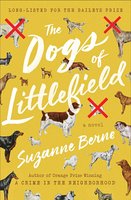The Dogs of Littlefield: A Novel
- By Suzanne Berne
- Simon & Schuster
- 288 pp.
- Reviewed by Molly Lundquist
- January 11, 2016
Who's killing the pooches in this "idyllic" Massachusetts town?

Littlefield, a (fictional) suburb of Boston, is listed as one of the top places to live in the U.S. An oasis in a world of trouble, its residents are sheltered, well-off, even coddled. This state of existence is as true for the town pets as it is for their owners — until someone begins to poison the dogs.
And so, in The Dogs of Littlefield, we have the hook for a British-style Cozy Mystery. Who is killing all the pups — and why?
The book's real mystery, though, lies elsewhere. It soon becomes clear that the dogs are a "symptom of a more systemic problem" and that the author's purpose is to peel away the town's suburban charm to reveal what's underneath.
And what's underneath is pervasive anxiety. Everyone is frightened, though of what is uncertain. Even children sense that something is "out of balance" — so out of balance that the town is home to “1,146 psychotherapists and 679 psychiatrists.”
Dr. Clarice Watkins, a visiting anthropologist, believes the residents must be the world's most "psychologically policed" population. With all their comfort and security, she wonders, why can't these people be happy? Here lies the deeper mystery.
Margaret Downing represents much of what is amiss in Littlefield — an "ordinary, oddly disquieting woman,” her anxiety is unsettling. She appears "besieged" or, as another character describes her, “a lovely woman, but an absolute wreck."
Much of the book's perspective centers on Margaret; unfortunately, she is not compelling enough to carry the novel. But the story moves back and forth among a number of other characters, resulting in a structure too diffuse for us to feel deeply invested in any one of them.
And that's a shame. It would have been good to spend more time with George Wechsler, the town's local author, or with crusty, 85-year-old Hedy Fischman. Hedy loves Edith Piaf because Piaf was proof you could "feel good about bad things."
There is some strong writing here and a good deal of humor. But a fair amount feels labored, a piling up of adjectives, especially in descriptions of nature. I counted more than a dozen mentions of sky color, ranging from pink to peach to gold to honey to blue to navy blue. While some reviewers find Berne's style "lyrical," I find it stagy.
When it comes to the book's ending, though, the reverse is true. The end falls flat — oddly anticlimactic given earlier attempts to ratchet up the suspense. Things are resolved (or not) in a somewhat offhand manner.
Still, the book's beautiful last line, "Trees, leaves, light, bird," echoes one of Berne's themes: an intimate connection between the human world and the natural one. It is there — in the splendor and resilience of nature — that Littlefielders might find consolation.
Molly Lundquist owns and operates LitLovers, a website providing resources to book clubs and solo readers. Prior to founding LitLovers, she worked for 15 years as a public-relations speech writer. She later earned an M.A. in English and worked for several years as a college English instructor.

